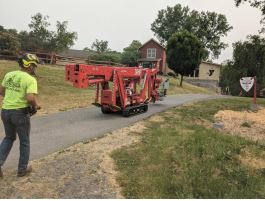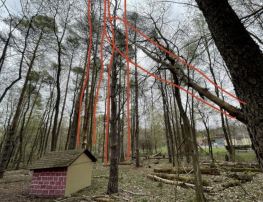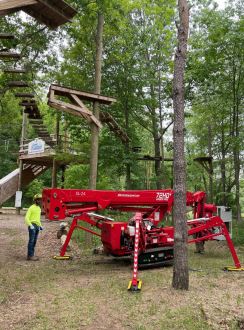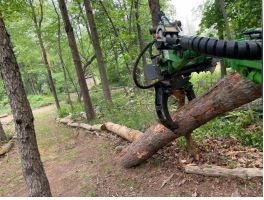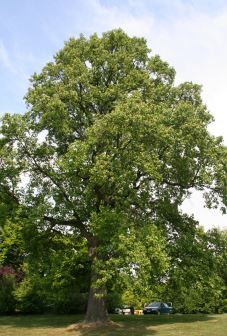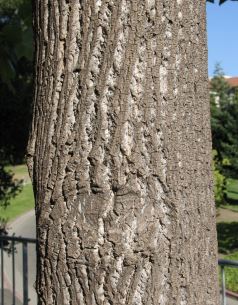Last month's newsletter dove deep into the topic of ticks and mosquitos. This month, we are going to dive deeper into the topic of Drought. Drought Stress on TreesWelcome summer! With summer comes the heat, and while we are able to go inside and cool off in front of the AC with a glass of water, our trees cannot. The summer season can be a challenging time for trees and plants, particularly in regions prone to drought. Drought stress is a condition that occurs when plants and trees don't receive enough water to meet their needs. During a drought, the soil may become so dry that water is no longer available to the roots, or the rate of water loss through the leaves may exceed the rate at which water can be absorbed by the roots. It's important to note that the effects of drought stress can vary depending on the specific conditions of each site, including soil type, moisture availability, and exposure to sunlight and wind. There are several strategies homeowners and landscapers can implement to help mitigate drought stress including adjusting irrigation practices and selecting drought tolerant species when planting! Rochester is home to many beautiful species of trees. However, some of our most popular trees do not tolerate water scarcity well. Trees in our area that are most susceptible to drought stress are:
Sycamore trees along this roadside are showing signs of stress as they dropped their leaves early, compared to the trees behind them that have full canopies. These trees are particularly vulnerable to drought stress because they have relatively shallow root systems and/or high water demands. You may notice reduced growth, or branches dying during prolonged periods of drought. Therefore, it is important to monitor trees regularly for signs of drought stress. One of the most noticeable signs of stress is wilting, where the leaves and stems become limp and droopy as the plant tries to conserve water. This is often accompanied by yellowing or browning of the leaves on the outer edges, which can eventually lead to leaf drop and defoliation. Without leaves, the tree's ability to complete photosynthesis is impaired. Leaves are also the site where vital functions like gas exchange, respiration, and the production of hormones and growth regulators take place.
These River Birch leaves have brown edges, which is a symptom of drought stress. When a plant or tree is under drought stress, it can experience a range of negative effects and respond in many ways. Drought stress can weaken a tree's natural defenses, making it more vulnerable to pests and diseases. For example, droughtstressed trees may be more susceptible to borers, cankers, and root rot. In severe cases, drought stress can even cause permanent damage or death to a plant or tree. Therefore, it's important to take steps to minimize the effects of drought stress, such as providing supplemental irrigation, mulching around the base of the tree to help retain moisture*, and avoiding overfertilization or other practices that can cause further stress. *Read our May newsletter to learn about proper mulching. How to combat drought stress:
You don't need a fancy irrigation system to water your trees! Alternative methods include using the hose end as is, a soaker hose, or a sprinkler. How can soil make a difference? Sandy soil has larger particles with more space between them, allowing water to move through quickly. On the other hand, clay soil has smaller particles that are tightly packed together, leading to slower drainage. When it comes to water retention for trees, loamy soil is generally considered the best. Loamy soil is a well-balanced mixture of sand, silt, and clay particles. It has good drainage due to the sand content, but also retains moisture well because of the clay and silt components. It's important to note that different tree species have varying preferences for soil moisture levels, and some may require specific soil conditions. A professional tree and plant health care company can provide a range of services to help your property battle drought stress and maintain healthy, vibrant trees. By working with Monster Tree Service of Rochester, you can ensure that your property is receiving the care it needs to thrive, even during periods of heat and drought! Find out more: Schedule a consultation with a Monster Arborist Cornell Cooperative Extension: Watering Trees NYS DEC Drought Watch Monster in the Neighborhood
Above: Mike, driving the lift in. Below: Trees that are highlighted were removed.
Our team spent three days on site at a YMCA of Greater Rochester camp, helping the camp prepare for their summer season by removing and pruning hazardous trees on the property. The majority of these trees were Scotch Pines and Ash. The Pines suffered from Pine Borer attacks and the Ash trees were damaged by Emerald Ash Borers. We were happy to help provide a safe and natural environment for the summer campers. Enjoy your summer!
Above: The crew setting up the lift by the aerial adventure course. Below: Our team repurposed the logs by creating trail edge borders around the camp
Tree Highlight |





